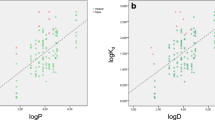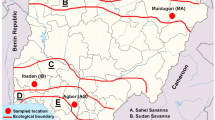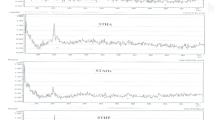Abstract
It is generally assumed that the sorption of a nonionic pesticide on soil depends mainly on the content of soil organic matter (SOM); however, there are other factors that can contribute to this process. The possible causes of variation in the carbon-normalized partition coefficient (K OC) for chlorpyrifos (CPF) for a diverse set of ten soils have been investigated. On the one hand, the analysis of the chemical composition of the SOM was analyzed, and on the other hand, the likely interactions between the organic matter and the mineral phase were assessed. Sorption experiments of CPF were performed on whole soil, on soils treated with 2% hydrofluoric acid (HF), and onto calcined soil at 550 °C. Organic matter chemistry of soil was determined by 13C CP/MAS NMR spectroscopy; K OC values were positively correlated with aryl C relative proportion and negatively correlated with alkyl C and O-aryl C proportions and prediction equation of K OC was found (R 2 = 0.82, p < 0.001). To evaluate possible organo-mineral interactions, a mathematical model was proposed which calculates the concentration of CPF at equilibrium (C cal) considering adsorption coefficients for the organic (K DHF) and inorganic (K D550 °C) soil constituents, separately. The comparison between C cal and the equilibrium concentration obtained from experimental data (C exp) onto whole soil allowed us to confirm that interactions between the OM and clay affect the adsorption of CPF in whole soil. Such findings should be taken into account in the development of predictive models for the evaluation of the fate and transport of this pesticide in soil.




Similar content being viewed by others
References
Ahangar, A. G., Smernik, R. J., Kookana, R. S., & Chittleborough, D. J. (2008a). Clear effects of soil organic matter chemistry, as determined by NMR spectroscopy, on the sorption of diuron. Chemosphere, 70, 1153–1160.
Ahangar, A. G., Smernik, R. J., Kookana, R. S., & Chittleborough, D. J. (2008b). Separating the effects of organic matter–mineral interactions and organic matter chemistry on the sorption of diuron and phenanthrene. Chemosphere, 72, 886–890.
Ahmad, R., & Kookana, R. S. (2002). Extrapolation of pesticide sorption data between agroclimatic region. In R. Kookana, R. Sadler, N. Sethunathan, & R. Naidu (Eds.), Environmental protection and risk assessment of organic contaminants (pp. 93–119). Enfield: Science Published.
Ahmad, R., Kookana, R. S., Alston, A., & Skjemstad, J. O. (2001). The nature of soil organic matter affects sorption of pesticides. 1. Relationships with carbon chemistry as determined by 13C CPMAS NMR spectroscopy. Environmental Science & Technology, 35, 878–884.
Ahmad, R., Nelson, P. N., & Kookana, R. S. (2006). The molecular composition of soil organic matter as determined by 13C NMR and elemental analyses and correlation with pesticide sorption. European Journal of Soil Science, 57, 883–893.
Baldock, J. A., Oades, J. M., Waters, A. G., Peng, X., Vassallo, A. M., & Wilson, M. A. (1992). Aspects of the chemical structure of soil organic materials as revealed by solid-state 13C NMR spectroscopy. Biogeochemistry, 16, 1–42.
Baskaran, S., Kookana, R. S., & Naidu, R. (2003). Contrasting behavior of chorpyrifos and its primary metabolite, TCP (3,5,6-trichloro-2-pyridinol), with depth in soil profiles. Australian Journal of Soil Research, 41, 749–760.
Bernier, M. H., Levy, G. J., Fine, P., & Borisover, M. (2013). Organic matter composition in soils irrigated with treated wastewater: FT-IR spectroscopic analysis of bulk soil samples. Geoderma, 209–210, 233–240.
Bonfleur, E. J., Kookana, R. S., Tornisielo, V. L., & Regitano, J. B. (2016). Organomineral interactions and herbicide sorption in Brazilian tropical and subtropical oxisols under no-tillage. Journal of Agricultural and Food Chemistry, 64(20), 3925–3934.
Carstea, E. M., Baker, A., Bieroza, M., Reynolds, D. M., & Bridgeman, J. (2014). Characterisation of dissolved organic matter fluorescence properties by PARAFAC analysis and thermal quenching. Water Research, 61, 152–161.
Celis, R., de Jonge, H., de Jonge, L. W., Real, M., Hermosin, M. C., & Cornejo, J. (2006). The role of mineral and organic components in phenanthrene and dibenzofuran sorption by soil. European Journal of Soil Science, 57, 308–319.
Chen, Z., & Pawluk, S. (1995). Structural variation of humic acids into sola of Alberta Mollisols. Geoderma, 65, 173–193.
Chiou, C. T. (1989). Theoretical considerations of the partition uptake of nonionic organic compounds by soil organic matter. In B. L. Sawhney & K. Brown (Eds.), Reactions and movement of organic chemicals in soils (pp. 1–29). Madison: Soil Science Society of America, Inc.
Chiou, C. T., Kile, D. E., Rutherford, D. W., Sheng, G., & Boyd, S. A. (2000). Sorption of selected organic compounds from water to a peat soil and its humic-acid and humin fractions: potential sources of the sorption nonlinearity. Environmental Science and Technology, 34, 1254–1258.
Coquet, Y., & Barriuso, E. (2002). Spatial variability of pesticide adsorption within the topsoil of a small agricultural catchment. Agronomie, 22, 389–398.
Demyan, M. S., Rasche, F., Schulz, E., Breulmann, M., Muller, T., & Cadisch, G. (2012). Use of specific peaks obtained by diffuse reflectance Fourier transform mid-infrared spectroscopy to study the composition of organic matter in a Haplic Chernozem. European Journal of Soil Science, 63, 189–199.
Ehlers Clark, G. A., Forrester, S. T., Scherr, K. E., Loibner, A. P., & Janik, L. J. (2010). Influence of the nature of soil organic matter on the sorption behaviour of pentadecane as determined by PLS analysis of mid-infrared DRIFT and solid-state 13CNMR spectra. Environmental Pollution, 158, 285–291.
Farenhorst, A. (2006). Importance of soil organic matter fractions in soil-landscape and regional assessments of pesticide sorption and leaching in soil. Soil Science Society of America Journal, 70, 1005–1012.
Farenhorst, A., Saiyed Ibrahim, M., Boon Goh, T., & Mc Queen, P. (2010). The important characteristics of soil organic matter affecting 2,4-dichlorophenoxyacetic acid sorption along a catenary sequence. Journal of Environmental Science and Health. Part. B, 45, 204–213.
Forouzangohar, M., Cozzolino, D., Kookana, R. S., Smernik, R. J., Forrester, S. T., & Chittleborough, D. J. (2009). Direct comparison between visible near- and mid-infrared spectroscopy for describing diuron sorption in soils. Environmental Science and Technology, 43, 4049–4055.
Gebremariam, S. Y., Beutel, M. W., Yonge, D. R., Flury, M., & Harsh, J. B. (2012). Adsorption and desorption of chlorpyrifos to soils and sediments. Reviews of Environmental Contamination and Toxicology, 215, 124–175.
Grathwohl, P. (1990). Influence of organic matter from soils and sediments from various origins on the sorption of chlorinated aliphatic hydrocarbons: implications of KOC correlations. Environmental Science and Technology, 24, 1687–1693.
Guerin, W. F., & Boyd, S. A. (1992). Differential bioavailability of solid-sorbed naphthalene to two bacterial species. Applied and Environmental Microbiology, 58, 1142–1152.
Gunasekara, A. S., & Xing, B. (2003). Sorption and desorption of naphthalene by soil organic matter: importance of aromatic and aliphatic components. Journal of Environmental Quality, 32, 240–246.
He, Y., Liu, Z., Su, P., Shen, X., Brookes, P. C., & Xu, J. (2014). A new adsorption model to quantify the net contribution of minerals to butachlor sorption in natural soils with various degrees of organomineral aggregation. Geoderma, 232–234, 309–316.
Heckman, K., Throckmorton, H., Clingensmith, C., Gonzalez Vila, F. J., Horwath, W. R., Knicker, H., & Rasmussen, C. (2014). Factors affecting the molecular structure and mean residence time of occluded organics in a lithosequence of soils under ponderosa pine. Soil Biology & Biochemistry, 77, 1–11.
Huang, X. J., & Lee, L. S. (2001). Effects of dissolved organic matter from animal waste effluent on chlorpyrifos sorption by soils. Journal of Environmental Quality, 30, 1258–1265.
IUPAC PPDB - Pesticides Properties DataBase. (2015). http://sitem.herts.ac.uk/aeru/iupac/. Accessed 27 July 2016.
Kaiser, M., & Ellerbrock, R. H. (2005). Functional characterization of soil organic matter fraction different in solubility originating from a long-term field experiment. Geoderma, 27(3), 196–206.
Kang, S., & Xing, B. (2005). Phenanthrene sorption to sequentially extracted soil humic acids and humins. Environmental Science and Technology, 39, 134–140.
Karickhoff, S. W. (1981). Semi-empirical estimation of sorption of hydrophobic pollutants on natural sediments and soils. Chemosphere, 10, 833–846.
Keil, R. G., & Mayer, M. (2014). Mineral matrices and organic matter. In E. Scott (Ed.), Earth systems and environmental sciences (pp. 337–359). UK: Royal Holloway, University of London.
Kile, D. E., Wershaw, R. L., & Chiou, C. T. (1999). Correlation of soil and sediment organic matter polarity to aqueous sorption of nonionic compounds. Environmental Science and Technology, 33, 2053–2056.
Knicker, H. (2011). Solid state CPMAS 13C and 15N NMR spectroscopy in organic geochemistry and how spin dynamics can either aggravate or improve spectra interpretation. Organic Geochemistry, 42, 867–890.
Knicker, H., & Ludeman, H. (1995). N-15 and C-13 CPMAS and solution NMR studies of N-15 enriched plant material during 600 days of microbial degradation. Organic Geochemistry, 23, 329–341.
Loewy, R. M., Monza, L. B., Kirs, V. E., & Savini, M. C. (2011). Pesticide distribution in an agricultural environment in Argentina. Journal on Environmental Science and Health, Part B, 46, 662–670.
Mahieu, N., Powlson, D. S., & Randall, E. W. (1999). Statistical analysis of published carbon-13 CPMAS NMR spectra of soil organic matter. Soil Science Society of America Journal, 63, 307–319.
Mao, J., Hundal, L. S., Thompson, M. L., & Schmidt-Rohr, K. (2002). Correlation of poly(methylene)-rich amorphous aliphatic domains in humic substances with sorption of a nonpolar organic contaminant, phenanthrene. Environmental Science and Technology, 36, 929–936.
Pignatello, J. J., & Xing, B. (1996). Mechanisms of slow sorption of organic chemicals to natural particles. Environmental Science Technology, 30, 1–11.
Rogers, M. R., & Stringfellow, W. T. (2009). Partitioning of chlorpyrifos to soil and plants in vegetated agricultural drainage ditches. Chemosphere, 75, 109–114.
Salloum, M. J., Dudas, M. J., & McGill, W. B. (2001). Variation of 1-naphthol sorption with organic matter fractionation: the role of physical conformation. Organic Geochemistry, 32, 709–719.
Singh, N., & Kookana, R. S. (2009). Organo-mineral interaction mask the true sorption potential of biochars in soils. Journal of Environmental Science and Health. Part. B, 44, 214–219.
Skjemstad, J. P., Dala, R. C., & Barron, P. F. (1986). Spectroscopic investigations of cultivation effects on organic matter of Vertisols. Soil Science Society of America Journal, 50, 354–359.
Smernik, R. J., & Kookana, R. S. (2015). The effects of organic matter–mineral interactions and organic matter chemistry on diuron sorption across a diverse range of soils. Chemosphere, 119, 99–104.
Wauchope, R. D., Yeh, S., Linders, J. B. H. J., Kloskowski, R., Tanaka, K., Rubin, B., Katayama, A., Kordel, W., Gerstl, Z., Lane, M., & Unsworth, J. B. (2002). Pesticide soil sorption parameters: theory, measurement, uses, limitations and reliability. Pest Management Science, 58, 419–445.
Wu, J. G., & Laird, D. A. (2004). Interactions of chlorpyrifos with colloidal materials in aqueous systems. Journal of Environmental Quality, 33, 1765–1770.
Xing, B., McGill, W. B., & Dudas, M. J. (1994). Cross-correlation of polarity curves to predict partition coefficients of nonionic organic contaminants. Enviromental Science and Tecnology, 28, 1929–1933.
Acknowledgments
The authors are grateful to the Secretaría de Ciencia y Técnica, Universidad Nacional del Comahue, Argentina, for the financial support. We also thank to Dra. Heike Knicker (Departament of Geoecología, Biogeoquímica y Microbiología Ambiental Instituto de Recursos Naturales y Agrobiología, Sevilla (IRNAS-CSIC) for her help in obtention and interpretation of 13C-NMR spectra.
Author information
Authors and Affiliations
Corresponding author
Rights and permissions
About this article
Cite this article
Savini, M.C., Loewy, R.M., Nicotra, V.E. et al. Contribution of Soil Components on the Sorption of Chlorpyrifos. Water Air Soil Pollut 228, 36 (2017). https://doi.org/10.1007/s11270-016-3153-z
Received:
Accepted:
Published:
DOI: https://doi.org/10.1007/s11270-016-3153-z




